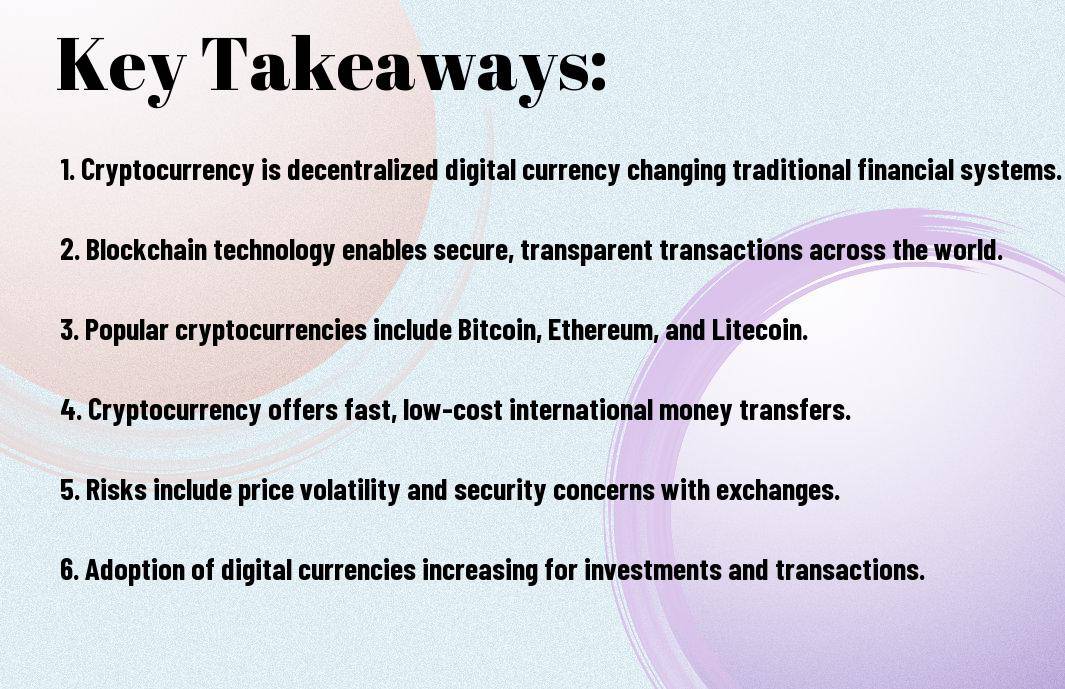Over the past decade, cryptocurrency has emerged as a revolutionary force reshaping the global economy. This digital form of money has the power to disrupt traditional financial systems, enabling secure and anonymous transactions across borders with minimal fees. In this blog post, we will probe the world of cryptocurrency, explaining how it works and the impact it is having on industries worldwide.
Key Takeaways:
- Cryptocurrency is a digital form of money: Cryptocurrency is a decentralized digital currency that relies on encryption techniques to regulate the generation of units and verify the transfer of funds.
- Blockchain technology powers cryptocurrencies: Blockchain is the underlying technology that enables the existence of cryptocurrencies. It is a distributed ledger that records all transactions across a network of computers.
- Bitcoin was the first cryptocurrency: Bitcoin, created in 2009 by an unknown person or group of people using the pseudonym Satoshi Nakamoto, was the first cryptocurrency and remains the most popular and widely accepted.
- Cryptocurrencies offer financial freedom: Cryptocurrencies provide individuals with greater control over their money, enabling faster and cheaper cross-border transactions and reducing the need for traditional banking systems.
- Risks and volatility are associated with cryptocurrencies: The value of cryptocurrencies can be highly volatile, and there are risks of hacking, fraud, and regulatory changes that investors must carefully consider.
- Initial Coin Offerings (ICOs) are a popular way to raise funds: ICOs have emerged as a new way for startups to bypass traditional venture capital funding and raise capital through the issuance of digital tokens or coins.
- Cryptocurrencies are evolving and gaining mainstream acceptance: As more companies and institutions adopt blockchain technology and cryptocurrencies, the digital assets are increasingly being integrated into various industries and becoming more accepted in mainstream society.


Understanding Cryptocurrencies
Little has revolutionized the world of finance like cryptocurrencies. A form of digital currency, cryptocurrencies have gained popularity due to their decentralized nature, security features, and potential for significant returns on investment. But to truly grasp the impact of cryptocurrencies, it is crucial to understand how they work and the different forms they can take.
The Technology Behind Cryptocurrencies: Blockchain
The technology behind cryptocurrencies is known as blockchain. This innovative technology serves as a decentralized ledger that records all transactions across a network of computers. Each transaction is verified by network participants, known as miners, who utilize complex algorithms to validate the transaction and add it to a block. Once a block is filled with transactions, it is added to the existing chain of blocks, creating a secure and transparent record of all transactions.
Types of Cryptocurrencies
Cryptocurrencies come in various forms, each with its own unique features and applications. Some of the most popular cryptocurrencies include Bitcoin, Ethereum, Ripple, Litecoin, and Stellar. Each of these cryptocurrencies operates on its blockchain and serves specific purposes within the digital economy. This diversified ecosystem allows for flexibility and innovation within digital currencies.
| Bitcoin | First and most popular cryptocurrency |
| Ethereum | Platform for decentralized applications and smart contracts |
| Ripple | Facilitates cross-border payments and financial transactions |
| Litecoin | Faster transaction speeds and lower fees compared to Bitcoin |
| Stellar | Focuses on providing affordable financial services to the unbanked |
This diverse range of cryptocurrencies caters to different needs and preferences within the digital economy, offering users a plethora of options for financial transactions, investments, and specialized applications. By understanding the unique features of each cryptocurrency, individuals can make informed decisions about their digital assets and leverage the benefits of this emerging technology.
Buying and Storing Cryptocurrencies
Many people are increasingly interested in buying and storing cryptocurrencies as digital assets gain popularity and acceptance in financial markets. In the context of acquiring cryptocurrencies, one of the main avenues is through cryptocurrency exchanges. These online platforms allow users to buy, sell, and trade a variety of digital currencies like Bitcoin, Ethereum, and Litecoin. It is necessary to choose a reputable cryptocurrency exchange that offers secure transactions and follows regulatory guidelines to safeguard your investments.
Cryptocurrency Exchanges
Storing your cryptocurrencies safely is crucial to protect your digital assets from unauthorized access or potential cyber threats. Digital wallets play a vital role in securely storing and managing your cryptocurrency holdings. These wallets can be either hardware-based or software-based, each offering its level of security and convenience. Implementing multi-factor authentication and encryption are additional security measures to enhance the protection of your digital assets.
Digital Wallets and Security Measures
An necessary aspect of using digital wallets is to back up your private keys and passphrases securely. Losing access to your wallet can result in the permanent loss of your cryptocurrencies. Regularly updating your wallet software and practicing safe internet habits can minimize the risk of falling victim to cyber attacks or scams. By taking proactive steps to secure your digital wallet, you can enjoy the benefits of decentralized and transparent transactions offered by cryptocurrencies.
How Cryptocurrencies Work
Transactions and the Role of Miners
For every transaction made with a cryptocurrency, it is recorded on a digital ledger known as a blockchain. This ledger is decentralized, meaning it is distributed across a network of computers, making it extremely secure and resistant to tampering. Miners play a crucial role in verifying and adding these transactions to the blockchain. They use their computational power to solve complex mathematical puzzles, and the first miner to solve the puzzle gets the opportunity to add the block of transactions to the ledger.
Smart Contracts and Decentralized Applications
Transactions involving cryptocurrencies can also incorporate smart contracts, which are self-executing contracts with the terms directly written into code. These contracts automatically execute actions once certain conditions are met, removing the need for intermediaries. Decentralized applications (dApps) operate on blockchain technology and offer various functionalities without a central point of control. They are censorship-resistant and provide users with a high level of security and privacy.
It is imperative to understand the potential of smart contracts and dApps, as they have the power to revolutionize industries by automating processes and increasing transparency. However, there is also a risk associated with bugs in smart contract code, leading to vulnerabilities that could be exploited by malicious actors.

The Impact of Cryptocurrencies
On Banking and Finance
Not familiar with the concept of Digital Money: What It Is, How It Works, Types, and Examples? Allow me to simplify it for you. Digital money refers to electronic money that is stored in a digital format, allowing for instant transactions and accessibility from anywhere in the world.
Any disruption in traditional banking systems is bound to raise eyebrows, and cryptocurrencies are no exception. The decentralized nature of cryptocurrencies challenges the traditional banking model, enabling individuals to have more control over their finances. This shift has forced banks to reevaluate their fee structures, services, and overall approach to customer satisfaction to stay competitive in this rapidly evolving landscape.
On Global Transactions and the Unbanked
Unbanked individuals in developing countries face numerous challenges when it comes to accessing financial services. Cryptocurrencies have the potential to bridge this gap by providing a secure and efficient means of financial transactions without the need for a traditional bank account.
As a result, individuals who were previously excluded from the traditional financial system can now participate in global transactions and access a wide range of financial services. This not only empowers the unbanked population but also fosters financial inclusion on a global scale, potentially reducing poverty and stimulating economic growth in underserved regions.

Legal and Regulatory Considerations
Despite the growing popularity and adoption of cryptocurrencies, the legal and regulatory frameworks surrounding digital currencies remain complex and constantly evolving. Governments around the world are grappling with how to regulate this new form of money, with some countries embracing it, while others are skeptical and have imposed strict regulations.
Cryptocurrency Regulations Around the World
With the decentralized nature of cryptocurrencies, it has presented challenges for regulators to monitor and control. Some countries, like Japan, have taken proactive measures to regulate the industry by recognizing certain cryptocurrencies as legal tender and implementing licensing requirements for exchanges. On the other hand, China has imposed a ban on cryptocurrency trading and initial coin offerings (ICOs).
Tax Implications and Compliance
The taxation of cryptocurrencies varies widely across different jurisdictions. In some countries, such as the United States, cryptocurrencies are treated as property for tax purposes, requiring individuals to report capital gains or losses on their transactions. The IRS has also issued guidelines on reporting cryptocurrency activities and has increased enforcement efforts to ensure compliance.
The taxation of cryptocurrencies can be complex, and individuals should consult with tax professionals to ensure they are fulfilling their obligations. Plus, ignoring tax implications of cryptocurrency transactions could lead to penalties, fines, or even criminal charges. It is important for individuals to keep detailed records of their cryptocurrency transactions and seek guidance to navigate the tax landscape effectively.
Cryptocurrency Investment Strategies
Now, when considering investing in cryptocurrencies, it is crucial to develop a well-thought-out strategy to navigate the complexities of this market. According to The Crypto Question: Bitcoin, Digital Dollars, and Future Money, understanding the market and the associated volatility is key. Cryptocurrency prices can fluctuate dramatically in a short period, driven by various factors such as market sentiment, regulatory developments, and technological advancements. It is crucial to stay informed about these factors and conduct thorough research before making any investment decisions.
Understanding the Market and Volatility
Any successful cryptocurrency investor should be aware of the market dynamics and how volatility can impact their investments. Volatility in the crypto market can present both opportunities and risks. While some investors thrive on the fast-paced nature of the market, others may find it too volatile for their risk tolerance. It is crucial to stay updated on market trends, conduct fundamental analysis of cryptocurrencies, and diversify your investment portfolio to mitigate risk.
Long-term vs. Short-term Investing
Cryptocurrency investment strategies can be broadly categorized into long-term and short-term investing approaches. Long-term investing focuses on holding assets for an extended period, often years, with the expectation that their value will appreciate significantly over time. On the other hand, short-term investing involves buying and selling cryptocurrencies within a shorter timeframe, taking advantage of price fluctuations to generate quick profits. Each approach has its own set of risks and rewards, and investors should align their strategy with their financial goals and risk tolerance.
To maximize the potential of cryptocurrency investments, investors should carefully consider their risk appetite, investment timeline, and market conditions. Long-term investing strategies require patience, discipline, and a long-term vision. While short-term investing can offer opportunities for quick gains, it also carries higher risks due to the volatile nature of the crypto market. Ultimately, a diversified investment portfolio that balances both long-term and short-term strategies can help investors navigate the dynamic cryptocurrency market and optimize their returns.
The Future of Cryptocurrencies
Once again, the world of cryptocurrencies is facing a pivotal moment as it continues to evolve and shape the future of global finance. With the increasing adoption of digital currencies and blockchain technology, it’s crucial to examine into what lies ahead for this innovative industry.
Advances in Cryptocurrency Technologies
To keep pace with the growing demands and expectations, developers are constantly striving to improve cryptocurrency technologies. Advancements such as scalability solutions, improved security measures, and enhanced privacy features are in the pipeline to make digital currencies more user-friendly and efficient. These technological breakthroughs aim to address current limitations and broaden the potential applications of cryptocurrencies beyond financial transactions.
Potential Challenges and Opportunities Ahead
Opportunities: As cryptocurrencies become more mainstream, new opportunities arise for individuals and businesses to participate in this digital economy. Increased adoption could lead to greater financial inclusion, reduced transaction costs, and enhanced efficiency in various sectors. Additionally, the growing interest from institutional investors and regulatory developments may pave the way for a more stable and mature market.
Potential: However, along with these opportunities come several challenges that the industry must navigate. The volatile nature of cryptocurrency prices, regulatory uncertainties, and security concerns pose significant risks to investors and users. It is crucial for stakeholders to address these challenges through collaboration, innovation, and regulatory clarity to ensure the long-term sustainability and growth of the cryptocurrency ecosystem.
FAQ
Q: What is Cryptocurrency?
A: Cryptocurrency is a digital or virtual form of money that uses cryptography for security. It operates independently of a central authority, such as a government or bank.
Q: How does Cryptocurrency work?
A: Cryptocurrency works on a technology called blockchain, which is a decentralized and distributed ledger that records all transactions across a network of computers.
Q: What are the benefits of using Cryptocurrency?
A: Some benefits of using Cryptocurrency include lower transaction fees, faster cross-border transactions, increased security and privacy, and accessibility to financial services for the unbanked population.
Q: What are the risks associated with Cryptocurrency?
A: Risks associated with Cryptocurrency include price volatility, regulatory uncertainty, security vulnerabilities, and the potential for scams and fraud in the market.
Q: How do I store Cryptocurrency?
A: Cryptocurrency can be stored in digital wallets, which can be hardware-based (hardware wallets) or software-based (online wallets, desktop wallets, mobile wallets).
Q: How can I buy Cryptocurrency?
A: Cryptocurrency can be purchased on online exchanges using traditional currencies or other cryptocurrencies. It can also be acquired through mining or other means of earning.
Q: Is Cryptocurrency legal?
A: The legality of Cryptocurrency varies by country. While some countries fully embrace and regulate Cryptocurrency, others have imposed restrictions or outright bans on its use.



